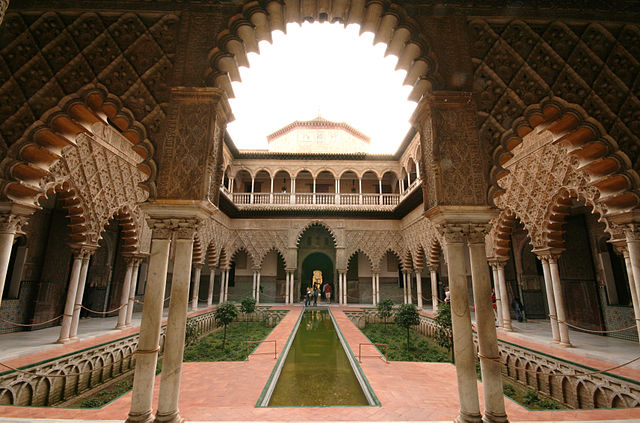An alcázar, from Arabic al-Qasr, is a type of Islamic castle or palace in Spain built during Muslim rule between the 8th and 15th centuries. They functioned as homes and regional capitals for governmental figures throughout the Umayyad caliphate and later, for Christian rulers following the Iberian Reconquista. The term alcázar is also used for many medieval castles built by Christians on earlier Roman, Visigothic or Islamic fortifications and is frequently used as a synonym for castillo or castle. In Latin America there are also several colonial palaces called Alcázars.
The Alcázar of Segovia, which dates back to the early 12th century, is one of the most famous medieval castles in the world and one of the most visited monuments in Spain.
A view of the Patio de las doncellas, a ṣaḥn within the Alcázar of Seville.
European and Christian iconography on azulejo at the Alcázar of Seville
Court of the Lions in the heart of the Alhambra, at night.
Alcázar of the Caliphs (Córdoba)
The Alcázar of the Caliphs or Caliphal Alcázar, also known as the Umayyad Alcázar and the Andalusian Alcazar of Cordoba, was a fortress-palace (alcázar) located in Córdoba, in present-day Spain. It was the seat of the government of Al-Andalus and the residence of the emirs and caliphs of Córdoba from the 8th century until the 11th century and the residence of local Muslim governors from the 11th century until the Christian conquest in 1236. The site was composed of heterogeneous constructions ranging from the private residences of the rulers and their households to the government offices and administrative areas. Today, only minor remains of the palace have survived, including the Caliphal Baths which have been converted into a museum. The rest of the site is occupied by later structures including the Alcázar de los Reyes Cristianos, the Episcopal Palace, the Seminary of San Pelagio, and the Campo Santos de los Mártires public square.

Remains of the outer wall of the Umayyad Alcazar incorporated into the façade of the Episcopal Palace today
The Albolafia waterwheel on the banks of the Guadalquivir river, built to provide water to the Alcázar and its gardens
The uncovered remains of the Caliphal Baths complex at the Campo Santos de los Mártires (photo from the 1990s, before the baths were converted to a museum)
The gardens and castle of the Alcazar of the Christian Kings today








